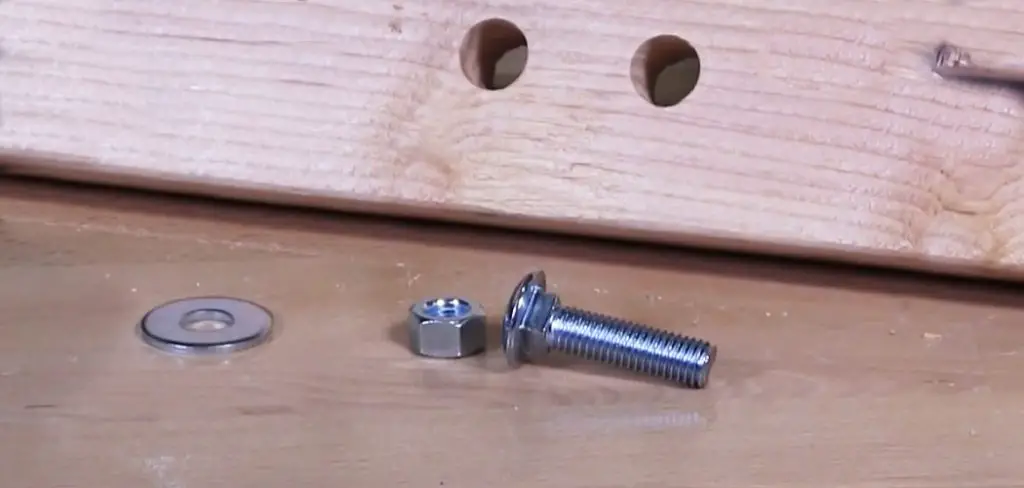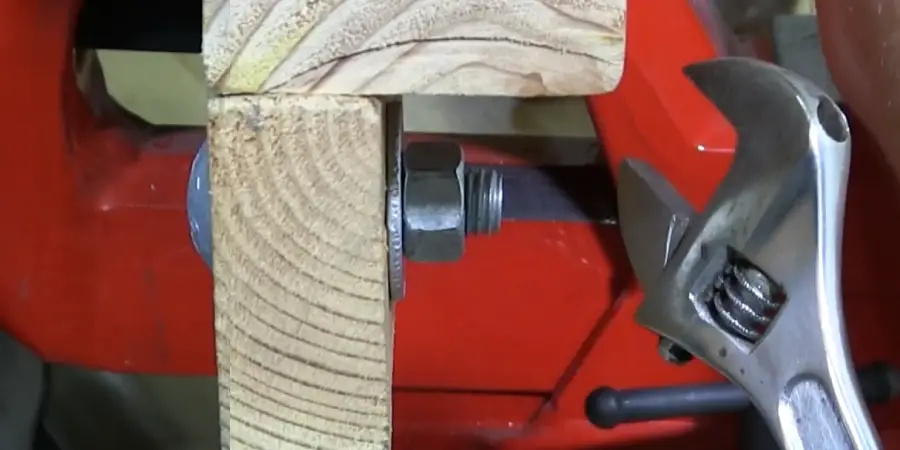Properly tightening carriage bolts is crucial for ensuring the strength and stability of your fastened connections. Whether you’re working on woodworking projects or structural applications, knowing the correct method to tighten carriage bolts is essential. The step-by-step guideline will walk you through the process, providing you with the knowledge and techniques to tighten carriage bolts effectively and securely.

How To Tighten Carriage Bolts: A Step-by-Step Guide
To tighten carriage bolts, you usually need a combination of tools.
- Drill with a drill bit
- Hammer
- Wrench or Socket Set
- Pliers or Vise Grips (Optional)
Here’s a step-by-step guide on how to properly install a carriage bolt and tighten it securely. Let’s find out the correct rule.
Step 1 – Choose the Correct Drill Bit
For creating holes in the wood, choosing a drill bit slightly smaller than the thread diameter of your carriage bolt is recommended. This ensures a snug fit of the bolt into the hole. Use special drill bits designed for drilling holes in wood.
Step 2: Drill the Hole
Mount the appropriate drill bit onto your drill machine and drill the hole. Pay close attention to ensure that the hole is straight, clean, and matches the thread size of the bolt precisely.
The head of the carriage bolt typically has a more extensive section, such as a square or nut-like shape. Using a slightly larger drill bit is recommended than the one used for the main hole. Drill approximately 1/4 inch deeper or adjust the depth based on the size of the extra part, creating space above the previous hole where the additional section of the carriage bolt will sit securely.
When tightening carriage bolts, the crucial aspect is to ensure a secure fit, where the bolt fits snugly into the hole and remains stationary without any movement.
Step 3: Insert the Carriage Bolt
Carefully insert the carriage bolt through the hole you drilled. To ensure a secure fit, firmly sit it and gently tap the carriage bolt with a hammer. Apply force to the head of the carriage bolt until it firmly engages with the wood, providing a secure connection.
Step 4: Secure and Tighten the Bolt
Begin by placing a washer onto the threaded end of the bolt, followed by a nut. To ensure a secure fastening, employ a wrench or socket set to tighten the nut firmly. Rotate the wrench or socket in a clockwise direction to tighten it.

Alternatively, you can utilize pliers or a vice grip to tighten the nut. Be cautious not to over-tighten, as this can damage the material or cause the threads to fray.
Note: It is crucial to ensure that the holes are not larger than the threads of the carriage bolts. Moreover, the hole in the square or nut-like part of the bolt head should be less extensive as it hinders the carriage bolt from spinning in its position when the nut is tightened. Therefore, it is essential to maintain an equal hole size for this specific part to ensure a tight and secure fit.
Torque And Tensile Specifications For Tightening Carriage Bolts
The torque and tensile strength requirements for carriage bolts depend on various factors, including the quality and material of the bolt. Below is a general chart to provide you with a rough approximate idea:
| Carriage Bolt Size | Minimum Tensile Strength (lb) | Recommended Torque Value (lb.) |
|---|---|---|
| 1/2″ | 8,500 | 37 ft |
| 1/4″ | 1,900 | 4 ft |
| 3/16″ | 1,050 | 20 in |
| 3/4″ | 20,000 | 130 ft |
| 3/8″ | 4,650 | 15 ft |
| 5/16″ | 3,140 | 8 ft |
| 5/8″ | 13,550 | 73 ft |
FAQ’s
Why Won’t My Carriage Bolt Tighten?
There are several possible reasons why a carriage bolt won’t tighten: insufficient torque, damaged threads, incorrect hole size, obstructions or misalignment, or insufficient grip. Check these factors to identify the issue and ensure a proper fit for the bolt to tighten securely.
Why Do Carriage Bolts Have Square Sections?
Carriage bolts have square sections beneath the bolt head to prevent rotation during installation. This square neck design ensures stability and secure fastening, particularly in applications where the bolt may be vibrating or moving.
Can Carriage Bolts Be Used In Soft Wood?
Yes, carriage bolts can be used in softwood. Carriage bolts are versatile fasteners that work well in softwood and hardwood applications.
However, it’s important to exercise caution when using carriage bolts in softwood. When installing carriage bolts in softwood, using limited torque or force during the tightening process is essential. Applying excessive torque to carriage bolts in softwood can lead to a risk of crushing or damaging the wood.
Additional Tips: Incorporating washers under the nut provides an added layer of security and helps distribute the load evenly.
Conclusion
In conclusion, knowing how to tighten carriage bolts properly is essential for ensuring the integrity of your projects. Following the step-by-step guide mentioned above, you can confidently tighten carriage bolts to achieve a secure and stable connection. Remember to use the appropriate tools, apply sufficient torque, and check for proper alignment.
Now that you have this valuable knowledge don’t hesitate to share it with your friends or comment below to engage in further discussion. Happy bolting!
Read More :
